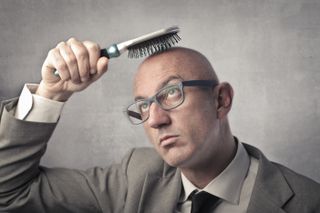Your Hair Can 'Smell', and It Just Might Like the Scent of Sandalwood

Like your nose, your hair can detect odors.
In a new study, researchers found that hair follicles contain olfactory receptors — the same kind of chemical receptors that lie deep in the nasal passages. In the nose, these receptors bind to odor molecules that waft in, sending signals to your brain to alert you that something reeks — or smells delicious.
What's more, the researchers found, these hair-follicle receptors can be activated by synthetic sandalwood to stimulate hair growth, according to the study, published Sept. 18 in the journal Nature Communications. (Several of the study authors have ties to Guiliani Pharma, an Italian pharmaceutical company that partly sponsored the research and that's filed a patent for using this synthetic cream for hair treatment).
But experts tell Live Science that this type of treatment, to banish baldness, is still a long way off.
A hair follicle that can "smell"
Olfactory receptors, or proteins with the ability to bind to odor molecules, were around long before organisms developed a sense of smell. The receptors are found in other tissues in the body beyond the nose, such as the gut or the heart. They are there for various reasons: in sperm cells, for example, the olfactory receptors are thought to help them track down eggs.
In the new study, researchers stained human scalp samples in the lab with fluorescent dyes and found that the hair follicles — or tissues that surround the root of the hairs — have a specific olfactory receptor called OR2AT4. [How to Fix 9 Common Skin Problems]
Previous research had shown that a man-made sandalwood scent called Sandalore — often used in cosmetics, perfume or cleaning products — can target this receptor found in skin cells called keratinocytes. These cells are also found in hair follicles and they produce keratin, the main protein that gives the hair strand its structure and protects it from damage.
Sign up for the Live Science daily newsletter now
Get the world’s most fascinating discoveries delivered straight to your inbox.
So, the researchers treated human hair follicles in lab dishes with Sandalore. They found that, after six days, the treatment greatly decreased the death of keratinocytes. They also found that Sandalore significantly increased the expression of a growth factor called iGF-1, a hormone that prolongs the growth phase (also called the anagen phase) of a hair follicle. During this phase, cells in the hair follicle rapidly divide and hair grows longer.
In addition, Sandalore significantly decreased the expression of another growth factor called TGF-b2, which promotes the second stage of hair growth, called the catagen phase. This phase is a transition period that lasts around 10 days before the hair enters the last phase of its life — the telogen phase. During the telogen phase, hair falls out.
Taken together, the findings suggest that "olfactory receptors may serve as a target in hair loss therapy," the researchers wrote.
But the study doesn't mean that people should go out and rub sandalwood scent all over their scalps.
That's because natural sandalwood doesn't bind to the OR2AT4 receptor, said senior study author Dr. Ralf Paus, a professor of dermatology at the University of Miami Miller School of Medicine and a professor of cutaneous medicine at the University of Manchester. Instead, only the synthetic version works.
However, other molecules can also bind to the OR2AT4 receptor to stimulate hair growth. Indeed, in order for hair to grow optimally, compounds that are naturally produced in the hair follicle continuously act on the receptor. The "next big challenge" for researchers, Paus said in an email, is to figure out what those natural molecules are.
A long road ahead
Dr. Marc Glashofer, a dermatologist specializing in hair loss at the Dermatology Group in northern New Jersey who was not part of the study, said that the new findings are "very impressive."
It's "exciting that the hair follicle can actually 'smell' and hair growth can be promoted by the use of chemicals and odorants," Glashofer told Live Science.
Still, in order for this to become a plausible treatment for hair loss, much more research is needed, including clinical trials where the treatment is actually given to patients, he said. It's not as easy as saying, "Let's throw this on there," he said. "You can throw a chemical on [the scalp] and it might not have the [properties] to penetrate to a certain level of the skin" where it can be effective.
Dr. Amy McMichael, a dermatologist at Wake Forest Baptist Health in North Carolina, who also specializes in hair loss and who was also not part of the work, agrees.
"The science is interesting and well-executed, but only as an early signal of possible involvement of olfactory receptors in the very complicated process of hair growth," McMichael told Live Science in an email. "While these findings are very exciting, they are too far removed from treating an actual patient."
Paus said, however, that scientists are "not far at all" from using this as a clinical treatment for hair loss. A clinical trial is currently ongoing, with results expected in early 2019, he said.
Originally published on Live Science.

Yasemin is a staff writer at Live Science, covering health, neuroscience and biology. Her work has appeared in Scientific American, Science and the San Jose Mercury News. She has a bachelor's degree in biomedical engineering from the University of Connecticut and a graduate certificate in science communication from the University of California, Santa Cruz.
Most Popular

